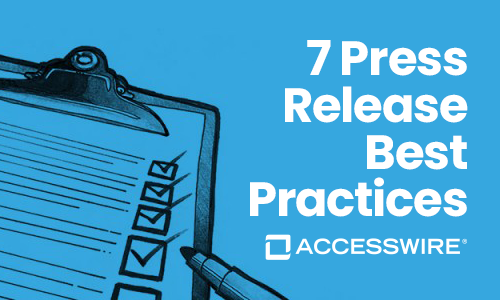Tips on How to Distribute a Press Release
Official press releases are one of the best opportunities your brand has to represent itself to the public. A resonant, pitch-perfect press release can redefine your brand identity, drive sales and stock value, boost web traffic and press
release
SEO recognition, and even placate unflattering media coverage about your brand sewn by competitors.
To meet each of these targets, an effective press release needs to be impeccably crafted for media outlet appeal. And once you’ve drafted, proofed, and double-proofed your press release writing, there are some make-or-break factors to consider before distributing it to the agents who’ll decide whether or not to send it off to PR distribution.
In this article, we’ll cover four critical steps to take before (and after) you submit a press release.
Who to Send it to: Building a Media List
First things first: determine what you are trying to accomplish with your press release distribution. Having a clear sense of your message, and what you aim to achieve by spreading the word, will determine who should receive your press or news release and how you can tailor its language and content for maximum appeal. Working with a press release distribution service will help make all these simpler for you.
Types of PR Distribution
Depending on the nature of your press release, there are two kinds of dispensation available to you:
- Macro-distribution – When a press release is dispensed to a high volume of recipients
- Micro-distribution – When a press release is dispensed to an exclusive, targeted circle of recipients
In both cases, press releases should be personable and addressed to a specific recipient on your media contact database whenever possible.
Because press release submissions can be expensive, PR actors typically choose their recipients carefully, based on which members of the press are most poised to publish and further disseminate the notice.
When deliberating on potential recipients, ask yourself which media outlet (and their audiences) holds interests most aligned with your business—this will dictate who has a stake in the message you’re trying to convey and, therefore, who is most likely to pick up your news release.
Where to Send it: The Local Edge
Whether you’re a national business or operating on a regional level, geography matters.Tailoring your press release to concerns that match a particular place makes it more probable your release will be picked up and broadcast to the targeted audience. When prepping a press release for local dispensation, be sure to integrate place-based terms and keywords as they may relate to your company. These may include:
- Names of local, municipal, or regional public figures
- Reference to regional sites, monuments, or venues
- Stats and data related to localized civil affairs
- Concerns, issues, and current events related to local welfare
The last thing an editor wants to receive is a press release that has no ties to the public their news outlet was built to serve and keep in the know. It’s important your messaging demonstrates an authentic relationship with your public, taps into the values and concerns, and reconciles the values of your business with outcomes desired by your target audience.
When to Send It: Timing Your Press Release
While the internet and social media have primed brands and their audiences for quicksilver communications, rushing out your press release as soon as it’s ready to go is rarely the most strategic option.
Different modes of disseminating company notices will require distinct approaches when it comes to timing, and while your information may be time-sensitive, it’s always preferable to play the media monitoring game tactically than to rush.
What time is right to issue a press release?
If business is booming, your brand is probably juggling incalculable communications on a day-to-day basis—so it’s no surprise you’ve adapted to scheduling emails ahead of time. Here are our main recommendations for maximizing the likelihood your press release gets noticed by a potential customer:
- Pick an off-kilter time – If you’re going to use scheduled emails to send out a press release, one technique to use is to set your emails towards an unconventional time, like 10:17 am. Journalists typically receive a blizzard of pre-arranged PR messaging at exactly 10:00 and 10:30 am, so refining your time to something less popular may get you noticed amid the competition.
- Avoid the wee hours – Whatever you do, don’t email a press release while the targeted journalist you want to contact is probably tucked in for the night. We also recommend avoiding dispensation between the hours of 6:00 pm and 10:00 am, when your recipient is unlikely to take much interest in your message.
- Don’t forget about time zones – Depending on the breadth of your brand’s influence, never forget to take time zones into account when scheduling a press release service. This is especially important for companies operating across international borders, so be sure to check the time zones of the outlets you want to reach.
What day is best to issue a press release?
The ease of communications means that journalists and editors are constantly barraged with PR queries. Above all, when possible, never issue a press release on a weekend, a Monday, or a Friday, which are overwhelming peak email congestion days for media outlets large and small.
Under what circumstances should I wait to send a press release?
The answer to this question comes down to the type of information you want to communicate. Here are some factors to consider when deciding on when to dispense your press release:
- Cultural climate – The same press release can garner journalistic interest or impassivity depending on the political or social atmosphere. If your press release touches on incendiary issues, or could be received as out-of-touch with the affairs of the moment, it may be worth putting a pause on its release and waiting for a more suitable time.
- Breaking News – If your press release is time-sensitive, issuing it ahead of the competition is the best way to take the reins on your brand’s story. To signal the time-bound nature of your message, be sure to title press releases with “FOR IMMEDIATE RELEASE” to the media contact.
- Crises and emergencies – The COVID-19 pandemic was a superlative example of companies taking responsibility for—and humanizing—their brand during a global health crisis. Whether your company is issuing a press release in response to an internal or public emergency, it’s always better to take the time to find your brand’s voice, take a stance, and respond to the event with conscience, candor, and tact.
Other time-bound occasions to consider timing pertain to brand events, product releases, or seasonal announcements (e.g. the holidays).
While press releases for brand-sponsored events should be issued three to four weeks before the occasion, products headed to market can be unveiled to the press later, usually between two and four weeks before release.
When should I use a news embargo?
A news embargo is a request your PR professional agent can make with journalists to delay the publication of confidential or sensitive company news.
You may want to consider using an embargo if your press release includes one or more of the following announcements:
- Information on company value, funding, or profits
- Mergers and acquisitions
- Retirement notices or onboarding of new leadership
Sent! What to Do After You’ve Issued Your Press Release
There are a few actions you should take care of after sending off your press release to encourage publication and maintain good standing with media outlets.
Here are our top three recommendations.
#1 Follow up
As we’ve mentioned, it’s likely your media list is contending with a deluge of other press releases from industry peers and competitors.
Your initial pitch should include why your story is in their interest to publish–but don’t be shy about stressing its relevance in your follow-up. Allow a day or two’s grace period for them to respond, and then send your follow-up.
#2 Build Relationships
You can create alliances with journalists whether or not they elect to put your story up for publication. It's also best to have all the contact information of your targeted journalists or trade publications for any future communication.
If they decline to publish your press release, politely ask them why. They could provide valuable insight for you to integrate into future pitches, and you could walk away with an ally at related trade publications for next time.
#3 Work the Metrics
Your emails can tell you an enormous amount of information about your reception—where you’re succeeding, and where you could build up your communications and public relations strategy.
The first metric to monitor is whether or not your message was opened, which will tell you whether your brand—and your subject line—warranted their attention. Next, assess how much time they devoted to reading your pitch, and whether they engaged with the content (i.e. if they followed any links).
If they opened your email and engaged with your pitch, but you still haven’t heard from them, the ball is in your court to follow up and drive home why their target audience has a stake in your story.
How to Distribute a Press Release Online: Let ACCESSWIRE Get the Word Out
Given the massive amount of media to sift through to make PR initiatives effective, your company will likely need to seek out a press release distribution service to take care of issuing press releases that get noticed and improve media relations.
ACCESSWIRE is your one-stop newswire service suite complete with press release distribution services, a fully customizable newsroom, and the data analytics prowess you need to guarantee your brand gets noticed. Let us guide you through this press release journey and answer any questions you may have. Whether that be how to write a press release or evaluating PR measurement, we have you covered.
Similar Blog Posts
PRODUCTS
ACCESSWIRE | All Rights Reserved




